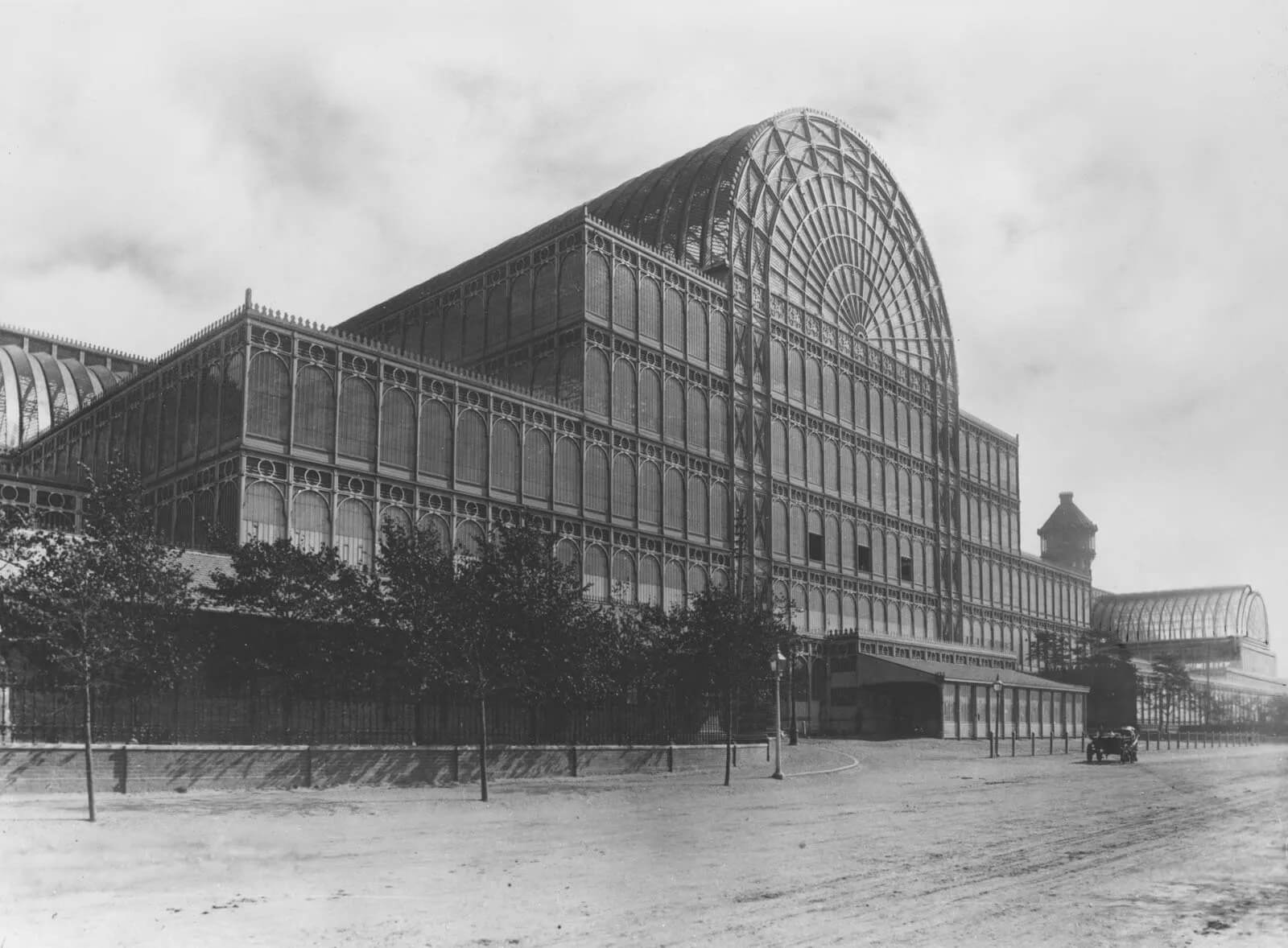Step inside the enchanting world of Crystal Palace, where history and architectural wonders intertwine. As the sunlight glimmers through its magnificent glass exteriors, this iconic structure stands tall, beckoning visitors to embark on a journey into the past. Uncovering the mystique of Crystal Palace unveils a captivating tale of opulence, innovation, and resilience. From its humble origins as the centerpiece of the Great Exhibition of 1851, Crystal Palace has etched itself into the annals of history. Brandishing its grandeur with unparalleled elegance, this architectural marvel became a symbol of Victorian ingenuity. Its vast open spaces housed countless treasures, showcasing the achievements of nations from all corners of the globe. Today, Crystal Palace’s legacy lives on, captivating both history enthusiasts and architectural aficionados. Explore the intricacies of its design, from the exquisite iron framework to the sprawling gardens that once graced its surroundings. Discover how it rose from the ashes to reclaim its former glory after a devastating fire in 1936. Join us on this fascinating journey through Crystal Palace’s rich history and iconic architecture, where secrets of the past are waiting to be unveiled. Prepare to be spellbound by its allure and immerse yourself in an era long gone.
Historical background of Crystal Palace
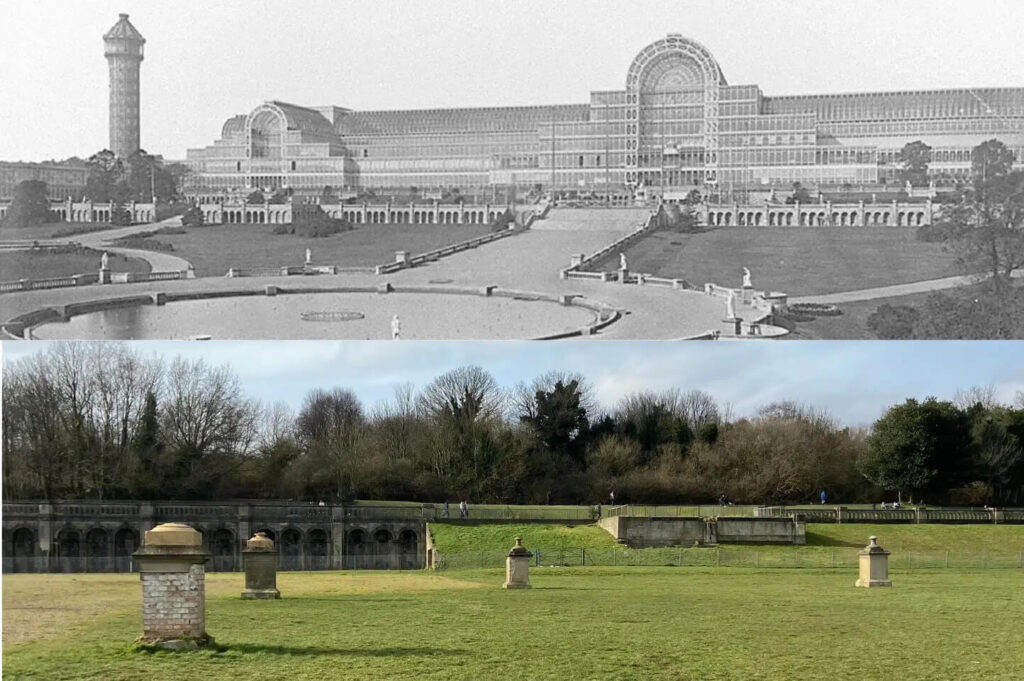
The Crystal Palace holds a significant place in history as an iconic symbol of innovation, industry, and culture. Here’s a brief historical background:
Origins and Construction:
- The Crystal Palace was built in London’s Hyde Park for the Great Exhibition of 1851, also known as the Crystal Palace Exhibition. The exhibition was conceived by Prince Albert, husband of Queen Victoria, and aimed to showcase the achievements of industry and culture from around the world.
- Designed by Sir Joseph Paxton, the Crystal Palace was an architectural marvel of its time. Its innovative design featured a vast iron and glass structure, which allowed for an abundance of natural light to illuminate the interior exhibition space.
The Great Exhibition of 1851:
- The Great Exhibition opened on May 1, 1851, and attracted over six million visitors during its six-month run. It showcased thousands of exhibits from various countries, including technological innovations, industrial machinery, artworks, and cultural artifacts.
- The Crystal Palace served as the centerpiece of the exhibition, housing the majority of the exhibits. Its grandeur and innovative design captivated visitors and became a symbol of progress and modernity.
Legacy and Impact:
- The success of the Great Exhibition and the Crystal Palace had a profound impact on society, culture, and industry. It promoted international trade and diplomacy, fostered a spirit of innovation and progress, and inspired future generations of architects, designers, and inventors.
- After the Great Exhibition, the Crystal Palace was relocated to Sydenham Hill in South London, where it was rebuilt and expanded. It served as a popular leisure destination, hosting exhibitions, concerts, and cultural events for several decades.
Decline and Destruction:
- Despite its initial success, the Crystal Palace faced financial difficulties in the late 19th century. The cost of maintenance and declining visitor numbers led to its eventual closure in 1936.
- Tragically, the Crystal Palace was destroyed by a devastating fire on November 30, 1936. The fire engulfed the entire structure, leaving behind only charred ruins and memories of its former glory.
Enduring Legacy:
- Although the Crystal Palace no longer stands, its legacy lives on in the collective memory of generations. It remains an enduring symbol of innovation, ambition, and cultural exchange, commemorated in literature, art, and historical accounts.
- The site of the Crystal Palace in Sydenham is now home to Crystal Palace Park, a public park that preserves the remnants of the original structure and provides a recreational space for visitors to enjoy.
The construction of Crystal Palace
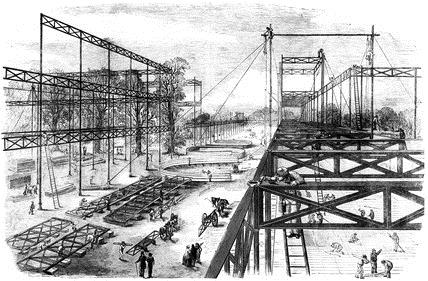
The construction of the Crystal Palace marked a pivotal moment in architectural history, showcasing innovative engineering techniques and materials that captivated the world. Here’s an overview of how this iconic structure came to be:
1. Design and Planning:
- The idea for the Crystal Palace emerged from discussions about hosting a grand exhibition to showcase the advancements of industry and culture. Prince Albert, the husband of Queen Victoria, played a key role in conceptualizing the project.
- Sir Joseph Paxton, a renowned architect and horticulturist, was selected to design the Crystal Palace. Paxton drew inspiration from his experience in greenhouse design, proposing a structure made entirely of iron and glass.
2. Innovative Materials and Construction:
- Paxton’s design for the Crystal Palace was groundbreaking for its use of prefabricated parts and modular construction techniques. The entire structure was composed of cast iron columns, wrought iron beams, and glass panes.
- The iron framework of the Crystal Palace was prefabricated in factories and assembled on-site in London’s Hyde Park. This prefabrication process allowed for rapid construction and minimized the need for skilled labor.
- The glass panes used in the Crystal Palace were specially manufactured to be larger and thinner than traditional glass, allowing for maximum light penetration and creating a bright and airy interior space.
3. Assembly and Completion:
- Construction of the Crystal Palace began in 1850, just one year before the opening of the Great Exhibition of 1851. Despite the ambitious timeline, Paxton’s innovative design and construction methods allowed for the rapid assembly of the structure.
- The Crystal Palace was completed in a remarkably short period of time, with construction taking less than a year from start to finish. Its grand opening on May 1, 1851, marked the beginning of the Great Exhibition, attracting millions of visitors from around the world.
4. Architectural Features:
- The Crystal Palace was characterized by its vast open interior space, supported by rows of slender iron columns and flooded with natural light from the glass roof. The absence of interior walls allowed for flexible exhibition layouts and panoramic views of the exhibits.
- The exterior of the Crystal Palace featured ornate ironwork detailing and decorative elements, including finials, cresting, and lattice patterns. These architectural features added to the structure’s grandeur and elegance.
5. Legacy and Impact:
- The completion of the Crystal Palace heralded a new era in architecture and engineering, demonstrating the possibilities of prefabrication, modular construction, and the use of iron and glass as architectural materials.
- The success of the Crystal Palace and the Great Exhibition of 1851 had a lasting impact on the fields of industry, commerce, and culture. It inspired future generations of architects, designers, and engineers and became a symbol of progress and modernity.
Architectural features of Crystal Palace
The Crystal Palace, renowned for its innovative design and architectural grandeur, boasted several distinctive features that contributed to its iconic status. Here’s a closer look at some of its key architectural features:
1. Iron and Glass Construction:
- One of the most remarkable architectural features of the Crystal Palace was its pioneering use of iron and glass in construction. Designed by Sir Joseph Paxton, the entire structure was composed of prefabricated cast iron columns, wrought iron beams, and glass panes.
- This revolutionary construction method allowed for the creation of a vast, open interior space flooded with natural light, giving the Crystal Palace its signature ethereal quality.
2. Modular Design:
- Paxton’s design for the Crystal Palace embraced a modular approach, with standardized components that could be mass-produced and assembled on-site. This modular design facilitated rapid construction and allowed for flexible layout configurations within the exhibition space.
- The use of prefabricated parts also minimized the need for skilled labor and reduced construction time, enabling the Crystal Palace to be completed in a remarkably short period.
3. Ornate Ironwork:
- The exterior of the Crystal Palace featured intricate ironwork detailing, including decorative finials, cresting, and lattice patterns. These ornate elements added to the structure’s visual appeal and gave it a sense of elegance and grandeur.
- The ornamental ironwork served both aesthetic and structural purposes, reinforcing the framework of the building while also enhancing its architectural beauty.
4. Grand Central Transept:
- The Crystal Palace was organized around a central transept, a vast, cathedral-like space that ran the length of the structure. The central transept served as the main thoroughfare for visitors, providing access to the various exhibition galleries and displays.
- This grand central space was flanked by rows of slender iron columns and punctuated by soaring arches, creating a sense of openness and grandeur that impressed visitors from around the world.
5. Glass Roof and Atriums:
- The most striking architectural feature of the Crystal Palace was its expansive glass roof, which covered the entire structure and allowed for abundant natural light to illuminate the interior space. The glass roof was supported by a network of iron trusses and ribs, creating a visually stunning canopy overhead.
- In addition to the main exhibition hall, the Crystal Palace also featured several smaller atriums and courtyards, which provided additional exhibition space and opportunities for visitors to gather and socialize.
6. Repeated Architectural Elements:
- Throughout the design of the Crystal Palace, Paxton employed a system of repeated architectural elements, such as arches, columns, and lattice patterns, to create visual coherence and harmony. These repeated motifs contributed to the overall unity and elegance of the structure.
- The use of repeated architectural elements also reinforced the modular nature of the design, highlighting the efficiency and economy of Paxton’s construction methods.
The Great Exhibition of 1851
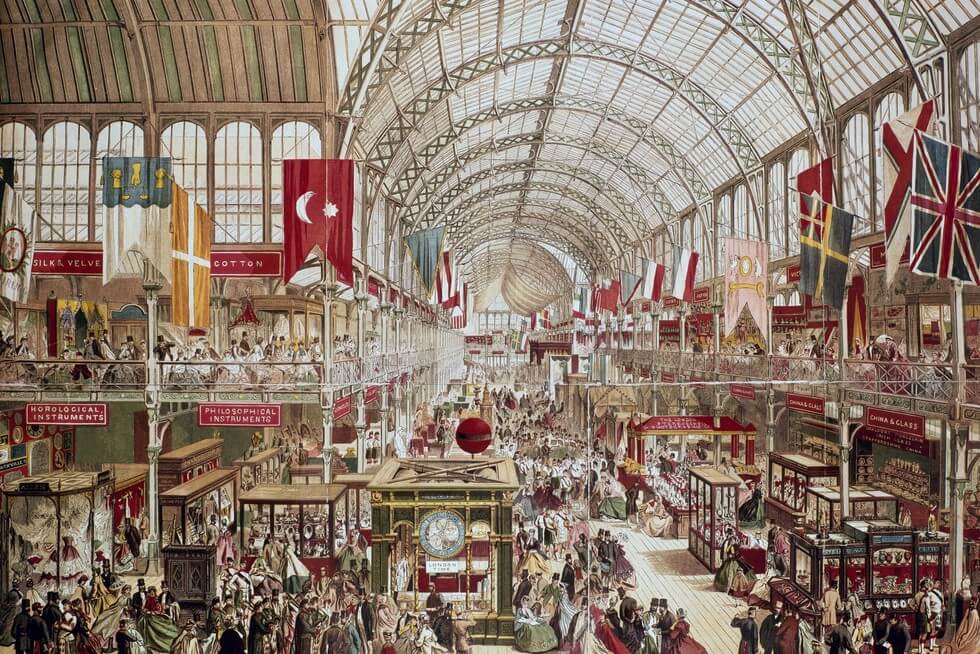
The Great Exhibition of 1851 stands as a landmark event in history, showcasing the pinnacle of human achievement in industry, culture, and innovation. Here’s an overview of this monumental exhibition:
1. Concept and Planning:
- The idea for the Great Exhibition originated from Prince Albert, the husband of Queen Victoria, who envisioned a grand international exposition to celebrate the advancements of industry and culture.
- The objective of the exhibition was to showcase the achievements of nations around the world, foster international cooperation and understanding, and promote trade and commerce.
2. Location and Venue:
- The Great Exhibition was held in London’s Hyde Park, with the centerpiece being the Crystal Palace, a grand iron and glass structure designed by Sir Joseph Paxton.
- The Crystal Palace was a marvel of engineering and architecture, boasting a vast interior space flooded with natural light, thanks to its innovative use of iron and glass construction.
3. Exhibits and Attractions:
- The Great Exhibition featured thousands of exhibits from over 25 countries, including technological innovations, industrial machinery, scientific instruments, artworks, and cultural artifacts.
- Exhibits were organized into categories such as machinery, raw materials, fine arts, and manufactures, allowing visitors to explore a wide range of disciplines and industries.
- Notable exhibits included the Koh-i-Noor diamond, the world’s largest diamond at the time, the Jacquard loom, a precursor to modern computer programming, and the Great Exhibition Telescope, a marvel of astronomical engineering.
4. Impact and Legacy:
- The Great Exhibition attracted over six million visitors during its six-month run, making it one of the most popular events of the 19th century.
- The exhibition had a profound impact on society, culture, and industry, sparking interest in science, technology, and innovation, and fostering a spirit of international cooperation and exchange.
- The success of the Great Exhibition laid the foundation for future international expositions, including the World’s Fair and Expo series, which continue to showcase the achievements of nations and promote global dialogue and cooperation.
5. Closing and Aftermath:
- The Great Exhibition concluded on October 15, 1851, after six months of continuous operation. A closing ceremony attended by Queen Victoria and Prince Albert marked the end of the exhibition.
- Following the exhibition, the Crystal Palace was dismantled and relocated to Sydenham Hill in South London, where it was rebuilt and expanded. It served as a popular leisure destination for several decades before being destroyed by fire in 1936.
Significance of Crystal Palace in Victorian England
The Crystal Palace held immense significance in Victorian England, serving as a symbol of progress, innovation, and cultural achievement. Here are some key aspects of its significance:
1. Technological Advancement:
- The construction of the Crystal Palace showcased Britain’s prowess in engineering and technology during the Industrial Revolution. Its innovative use of iron and glass construction techniques demonstrated the capabilities of Victorian engineering and set new standards for architectural design.
- The Crystal Palace represented a triumph of modernity over tradition, embodying the spirit of progress and innovation that characterized Victorian England. Its revolutionary design and construction methods captivated the imagination of the public and cemented Britain’s reputation as a global leader in industry and innovation.
2. Cultural Showcase:
- As the centerpiece of the Great Exhibition of 1851, the Crystal Palace served as a platform for showcasing the cultural achievements of nations from around the world. It housed thousands of exhibits representing a wide range of disciplines, including industry, art, science, and craftsmanship.
- The Great Exhibition promoted cultural exchange and understanding among nations, fostering a spirit of international cooperation and collaboration. It provided an opportunity for visitors to marvel at the wonders of human creativity and ingenuity and to appreciate the diversity of cultures and civilizations.
3. Economic Impact:
- The Great Exhibition had a significant economic impact on Victorian England, stimulating trade and commerce and boosting the British economy. The exhibition attracted millions of visitors from across the globe, generating revenue from ticket sales, concessions, and souvenir purchases.
- The success of the Great Exhibition helped to promote British exports and showcase the nation’s industrial products to an international audience. It also fostered relationships between British manufacturers and foreign buyers, leading to increased trade and investment opportunities.
4. National Identity:
- The Crystal Palace became a symbol of national pride and identity for the people of Victorian England. It represented Britain’s achievements in industry, science, and culture and served as a testament to the nation’s strength and resilience.
- The Crystal Palace embodied the ideals of progress, enlightenment, and modernity that characterized Victorian society. It inspired a sense of optimism and confidence in the future and reinforced Britain’s position as a global superpower.
5. Legacy:
- Despite the eventual loss of the original Crystal Palace to fire in 1936, its legacy continues to endure in the collective memory of the British people. The site of the Crystal Palace in Sydenham is now home to Crystal Palace Park, a public park that preserves the remnants of the original structure and serves as a reminder of its historic significance.
- The Crystal Palace remains an iconic symbol of Victorian England, representing an era of innovation, prosperity, and cultural achievement. Its legacy lives on as a testament to the enduring spirit of progress and ingenuity that defined the Victorian age.
The fire and destruction of Crystal Palace
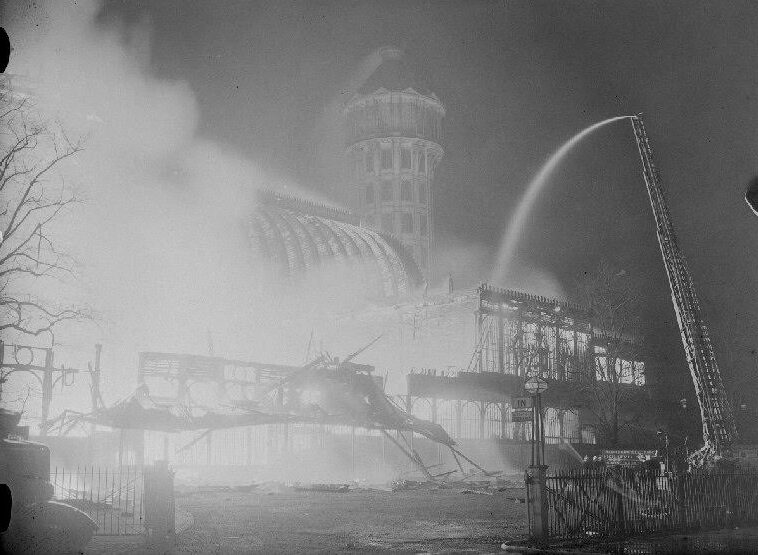
The fire and destruction of the Crystal Palace marked the end of an era and represented a significant loss for Victorian England. Here’s an overview of the tragic event:
1. Context:
- The Crystal Palace had been relocated to Sydenham Hill in South London after the closure of the Great Exhibition of 1851. It served as a popular leisure destination, hosting exhibitions, concerts, and cultural events for several decades.
2. The Fire:
- On the evening of November 30, 1936, a devastating fire broke out at the Crystal Palace, engulfing the entire structure in flames. The fire quickly spread throughout the building, fueled by the timber flooring and dry wooden fixtures.
- Firefighters battled the blaze for hours, but their efforts were hampered by the intensity of the fire and the lack of adequate water supply. Despite their best efforts, the Crystal Palace was reduced to smoldering ruins by the morning.
3. Destruction:
- The fire consumed the iconic iron and glass structure of the Crystal Palace, leaving behind only charred remnants of its former grandeur. The once-magnificent building, which had stood as a symbol of progress and innovation, was reduced to rubble.
- The destruction of the Crystal Palace sent shockwaves through Victorian England and was mourned as a national tragedy. It represented the loss of a cultural landmark and a cherished symbol of Britain’s industrial and cultural achievements.
4. Aftermath:
- In the wake of the fire, efforts were made to salvage and preserve what remained of the Crystal Palace site. Some of the surviving ironwork and architectural elements were salvaged and repurposed in other construction projects.
- Crystal Palace Park, which had been developed around the original Crystal Palace site, continued to attract visitors, albeit without the iconic structure that had once dominated the landscape.
5. Legacy:
- Despite its destruction, the legacy of the Crystal Palace endures in the collective memory of the British people. It remains a symbol of Victorian ingenuity, innovation, and cultural achievement.
- The site of the Crystal Palace serves as a reminder of its historic significance, and efforts have been made to commemorate its legacy through historical markers, exhibits, and public art installations.
Legacy of Crystal Palace
The legacy of the Crystal Palace extends far beyond its physical presence, leaving an indelible mark on history and culture. Here are some aspects of its enduring legacy:
1. Architectural Innovation:
- The Crystal Palace revolutionized architectural design with its pioneering use of iron and glass construction. Its innovative design and engineering techniques paved the way for modern architectural marvels and inspired generations of architects and engineers.
- The Crystal Palace demonstrated the potential of prefabricated components and modular construction methods, setting new standards for efficiency, economy, and sustainability in building design.
2. Symbol of Progress:
- As the centerpiece of the Great Exhibition of 1851, the Crystal Palace symbolized the spirit of progress, innovation, and modernity that characterized Victorian England. It showcased the achievements of industry, science, and culture from around the world and inspired optimism about the future.
- The Crystal Palace served as a tangible representation of Britain’s industrial and imperial dominance, reinforcing its status as a global superpower and fostering national pride and identity.
3. Cultural Icon:
- The Crystal Palace became an iconic symbol of Victorian England, celebrated for its architectural beauty, technological ingenuity, and cultural significance. It captured the imagination of the public and left a lasting impression on the collective memory of generations.
- The Crystal Palace inspired numerous works of art, literature, and popular culture, immortalizing its image in paintings, books, and films. Its legacy continues to resonate in the cultural consciousness, serving as a source of inspiration and fascination.
4. Public Parks and Gardens:
- Following the destruction of the original Crystal Palace in 1936, the site was transformed into Crystal Palace Park, a public green space that preserves the remnants of the historic structure. The park remains a popular destination for recreation, relaxation, and reflection.
- Crystal Palace Park is home to a variety of attractions, including lakes, sculptures, and sports facilities, as well as the remnants of the Crystal Palace’s foundations and infrastructure. It serves as a living testament to the legacy of the Crystal Palace and its impact on the local community.
5. Influence on World’s Fairs and Expositions:
- The success of the Great Exhibition and the Crystal Palace inspired the creation of subsequent world’s fairs and international expositions, which aimed to showcase the achievements of nations and promote global cooperation and understanding.
- The legacy of the Crystal Palace lives on in the tradition of world’s fairs and expositions, which continue to celebrate innovation, culture, and progress on a global scale. Its influence can be seen in the design and organization of these events, as well as their impact on international relations and commerce.
Visiting Crystal Palace today
Visiting Crystal Palace today offers a blend of history, recreation, and greenery, providing visitors with an opportunity to explore the remnants of the iconic structure and enjoy the surrounding park. Here’s what you can expect when visiting Crystal Palace today:
1. Crystal Palace Park:
- The main attraction of a visit to Crystal Palace is the expansive Crystal Palace Park, which covers over 200 acres of landscaped grounds.
- The park features picturesque lakes, woodlands, gardens, and open spaces, providing ample opportunities for leisurely walks, picnics, and outdoor activities.
- Visitors can explore the park’s various attractions, including the dinosaur sculptures, which are replicas of the original sculptures created for the Crystal Palace’s grounds in the 1850s.
2. Historic Remnants:
- While the original Crystal Palace was destroyed by fire in 1936, the site still contains some historic remnants and architectural features that hark back to its illustrious past.
- Visitors can see the remains of the Crystal Palace’s foundations, including the base of the central transept, which once housed the grand exhibition hall.
- Interpretive panels and markers throughout the park provide information about the history and significance of the Crystal Palace and its role in the Great Exhibition of 1851.
3. Crystal Palace Museum:
- Located within Crystal Palace Park, the Crystal Palace Museum offers insight into the history of the Crystal Palace and its impact on Victorian society.
- The museum features exhibits, artifacts, and interactive displays that trace the evolution of the Crystal Palace from its inception to its eventual destruction.
- Visitors can learn about the construction, architecture, and cultural significance of the Crystal Palace, as well as its legacy in the modern era.
4. Recreation and Events:
- Crystal Palace Park hosts a variety of events, activities, and recreational opportunities throughout the year, including concerts, festivals, and sports tournaments.
- The park’s sports facilities, including football pitches, tennis courts, and a skate park, provide options for active recreation and fitness.
- Visitors can also enjoy seasonal events such as fireworks displays, outdoor theatre performances, and Christmas markets, which add to the park’s vibrant atmosphere.
5. Dining and Amenities:
- The park offers a range of dining options, including cafes, kiosks, and picnic areas where visitors can enjoy refreshments and snacks.
- Amenities such as restrooms, playgrounds, and visitor centers are available to enhance the visitor experience and ensure comfort and convenience during your visit.
6. Accessibility:
- Crystal Palace Park is easily accessible by public transportation, with several bus and train routes serving the area. Parking facilities are also available for visitors arriving by car.
- The park is wheelchair accessible, with paved pathways and ramps providing access to most areas. Accessible amenities and facilities ensure that all visitors can enjoy the park’s attractions and amenities.
Conclusion
In conclusion, the Crystal Palace holds a significant place in history as a symbol of innovation, progress, and cultural achievement. From its groundbreaking construction and role as the centerpiece of the Great Exhibition of 1851 to its tragic destruction and legacy in the modern era, the Crystal Palace has captured the imagination of generations and left an indelible mark on the landscape of Victorian England.
While the original structure may be gone, the legacy of the Crystal Palace lives on in the remnants of its foundations, the artifacts preserved in museums, and the memories of those who experienced its grandeur firsthand. Today, visitors to Crystal Palace Park can explore the historic site, enjoy the park’s amenities, and learn about the fascinating history of this iconic landmark.
As we reflect on the legacy of the Crystal Palace, we are reminded of the power of human creativity, ingenuity, and ambition to shape the world around us. Its story serves as a testament to the enduring spirit of progress and innovation that continues to inspire and captivate us to this day.
Author bio:
Hello, I am a professional SEO Expert & Write for us Technology blog and submit a guest posts on different platforms- we provides a good opportunity for content writers to submit guest posts on our website. We frequently highlight and tend to showcase guests.

